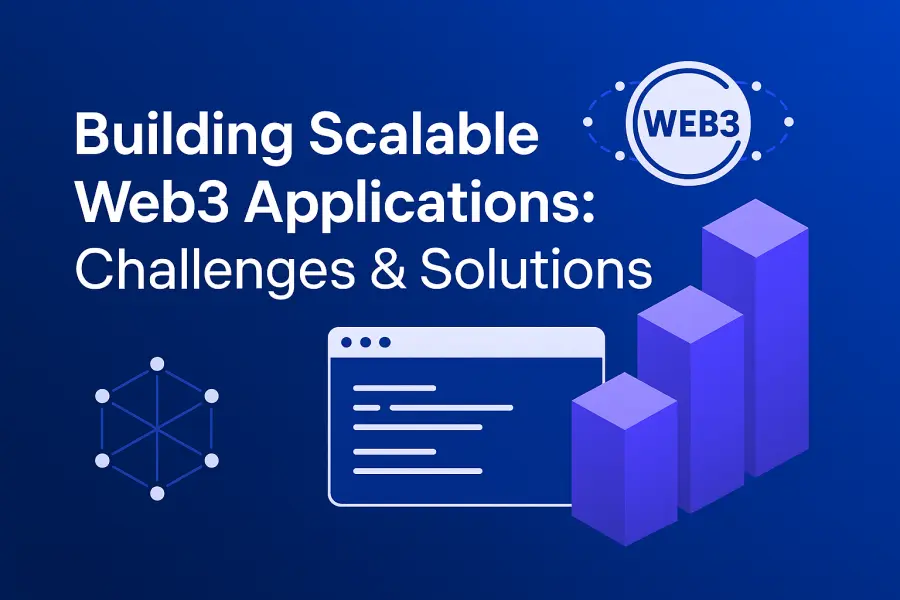The Web3 ecosystem is rapidly evolving, offering decentralized experiences that prioritize transparency, user ownership, and trustlessness. However, as adoption grows, so does the pressure to build Web3 applications that are scalable, reliable, and user-friendly.
Startups and enterprises diving into the blockchain space often find that scaling Web3 dApps isn’t as straightforward as scaling Web2 platforms.
From congestion and latency to smart contract bottlenecks, building scalable Web3 apps involves solving deeply technical and ecosystem-specific issues.
This blog explores the core challenges developers face in scaling Web3 solutions and outlines actionable strategies to overcome them in 2025 and beyond.
Key Challenges in Building Scalable Web3 Applications
Building scalable Web3 applications involves overcoming hurdles like network congestion, limited interoperability, complex development environments, and high gas fees. Developers must address these to ensure decentralized apps perform reliably under increasing user loads and evolving blockchain ecosystems.
Blockchain Throughput and Network Congestion
Most base-layer blockchains, especially Ethereum, face limited transaction throughput. High demand leads to network congestion, increased gas fees, and slower processing times. For example, NFT drops or DeFi liquidations often cause network-wide slowdowns.
Scalability is hindered by on-chain limitations in transactions per second (TPS). User experience suffers, and costs become unpredictable for both users and developers.
Smart Contract Limitations
Smart contracts are deterministic and require precise, efficient design. Poorly optimized contracts can lead to gas inefficiencies and failed transactions. Also, contract upgrades are challenging, which affects future scalability.
Lack of flexibility in smart contract design impedes iterative scaling. Refactoring contracts often means redeployment and data migration, an operational burden.
Data Storage and On-Chain Costs
Storing data on-chain is expensive and inefficient. While IPFS and Filecoin offer alternatives, managing large-scale, reliable decentralized storage solutions still poses architectural challenges.
On-chain storage is limited and costly. Developers must find the right balance between decentralization and cost-effective data handling.
Interoperability Between Chains
Web3 apps increasingly use multi-chain architectures. However, communication between chains remains unreliable or requires trusted bridges, many of which have been exploited in high-profile hacks.
Lack of secure cross-chain communication frameworks. Limits dApp expansion and puts user assets at risk during inter-chain operations.
User Experience (UX) and Wallet Management
Web3’s reliance on wallet integrations, seed phrases, and network switching creates a steep learning curve for new users. The friction negatively impacts app retention and scalability.
Web3 UX is unintuitive for mainstream users. Slows adoption rates and complicates user onboarding at scale.
Developer Tooling and Infrastructure Gaps
While frameworks like Hardhat and Truffle help streamline development, testing and debugging in decentralized environments remains harder than in Web2. Real-time monitoring, analytics, and devtools are still evolving.
Lack of robust dev environments and monitoring tools. Longer dev cycles and more frequent post-deployment bugs.
Scalable Solutions for Web3 Application Development
To overcome these hurdles, developers and enterprises must adopt a layered, forward-looking approach to building and scaling decentralized apps. Below are actionable solutions that address these core challenges. We recommend you to hire an experienced blockchain development company like Technoloader, as their developer will help you in overcoming these challenges.
Leverage Layer 2 Scaling Solutions
Technologies like Optimistic Rollups (Optimism, Arbitrum) and ZK-Rollups (zkSync, StarkNet) reduce load on base chains while offering faster transaction finality and lower fees.
Up to 10–100x higher throughput without compromising decentralization. Choose rollups based on your dApp’s transaction types, ZK for privacy and speed, Optimistic for general use.
Use Modular Blockchain Architectures
Modular chains like Celestia, Avail, and Polygon CDK separate execution, consensus, and data availability. This allows developers to create custom chains optimized for their app’s needs.
Greater scalability and customization, especially for enterprise-grade apps. Modular frameworks enable future-proofing your dApp infrastructure for growth and specialization.
Adopt Hybrid Storage Models
Combine on-chain verification with off-chain decentralized storage (e.g., Arweave, Filecoin, IPFS) for efficient and cost-effective data handling.
Reduces costs without compromising data immutability or decentralization. Only store hashes and critical data on-chain while leveraging content-addressed storage for bulk data.
Enable Cross-Chain Communication Safely
Use audited interoperability protocols like Axelar, LayerZero, or Wormhole for secure cross-chain messaging. Avoid unverified or centralized bridges.
Expand your app across multiple chains without fragmenting the user experience. Implement fallback mechanisms in case bridge endpoints fail.
Focus on Web3 UX Abstraction
Use tools like Web3Auth, Magic, or Coinbase WaaS to enable social logins, gasless transactions, and auto-network detection. Minimize wallet popups and seed phrase dependencies.
Streamlines user onboarding and boosts adoption. Design UX flows that feel like Web2 but operate over decentralized infrastructure.
Invest in Developer Tooling and Testing
Use simulators like Foundry, Tenderly, and Hardhat for local testing and debugging. Monitor live deployments with tools like Dune Analytics, Nansen, and The Graph.
Reduces debugging time and improves product reliability post-launch. Integrate CI/CD pipelines with smart contract testing for seamless updates.
Final Words
Building scalable Web3 applications is no longer just a technical feat; it’s a competitive necessity. The combination of layer-2 protocols, modular designs, intuitive UX, and secure interoperability gives developers the power to deploy applications ready for mass adoption.
At Technoloader, we as a leading Web3 development company specialize in building high-performance, scalable dApps tailored for the decentralized economy. Whether you’re launching a DeFi project, an NFT platform, or an enterprise-grade Web3 solution, our blockchain experts can turn your vision into a seamless and scalable product.
Need help scaling your Web3 project? Contact Technoloader today to schedule a free consultation with our blockchain experts.
 +91 7014607737
+91 7014607737
 info@technoloader.com
info@technoloader.com



